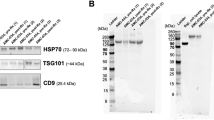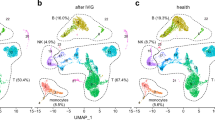Abstract
Cell surface expression of CD86 (mCD86) provides an important co-stimulatory signal which profoundly influences immune responses. In this report, we investigated the potential presence of a circulating soluble form of CD86 (sCD86) in normal individuals and patients with acute myeloid leukaemia (AML) or B cell chronic lymphocytic leukaemia (B-CLL). Circulating sCD86 was detected in the plasma of all normal individuals (1.04 ± 0.33 ng/ml, n = 51) and patients analysed. Plasma collected from AML patients in remission (n = 6) contained only low levels of sCD86 but significantly elevated levels (⩾2.65 ng/ml, P < 0.0001) were detected in 10/24 AML patients analysed at the time of presentation or relapse. Significantly elevated levels of sCD86 were also detected in 2/17 B-CLL patients. There was no correlation between sCD86 levels and other clinical parameters. RT-PCR analysis demonstrated that normal monocytes and dendritic cells, as well as isolated AML (n = 2) and B-CLL (n = 4) cells, expressed an alternatively spliced transcript of CD86 which encoded a soluble form absent in normal T, B and NK cells. The finding that a proportion of leukaemia patients contain elevated levels of sCD86 and that at least some leukaemic cells express sCD86 transcript suggests a potential role for sCD86 in modulating mCD86 signalling during the malignant process.
This is a preview of subscription content, access via your institution
Access options
Subscribe to this journal
Receive 12 print issues and online access
$259.00 per year
only $21.58 per issue
Buy this article
- Purchase on Springer Link
- Instant access to full article PDF
Prices may be subject to local taxes which are calculated during checkout





Similar content being viewed by others
References
Mueller DL, Jenkins MK, Schwartz RH . Clonal expansion versus functional clonal inactivation: a costimulatory signalling pathway determines the outcome of T cell antigen receptor occupancy Ann Rev Immunol 1989 7: 445–480
Lenschow DJ, Walunas TL, Bluestone JA . CD28/B7 system of T cell costimulation Ann Rev Immunol 1996 14: 233–258
Azuma M, Ito D, Yagita H, Okumura K, Phillips JH, Lanier LL, Somoza C . B70 antigen is a second ligand for CTLA-4 and CD28 Nature 1993 366: 76–79
Freeman GJ, Gribben JG, Boussiotis VA, Ng JW, Restivo VA Jr, Lombard LA, Gray GS, Nadler LM . Cloning of B7–2: a CTLA-4 counter-receptor that costimulates human T cell proliferation Science 1993 262: 909–911
Freeman GJ, Freedman AS, Segil JM, Lee G, Whitman JF, Nadler LM . B7, a new member of the Ig superfamily with unique expression on activated and neoplastic B cells J Immunol 1989 143: 2714–2722
Harding FA, McArthur JG, Gross JA, Raulet DH, Allison JP . CD28-mediated signalling co-stimulates murine T cells and prevents induction of anergy in T-cell clones Nature 1992 356: 607–609
Sansom DM . Review article: CD28, CTLA-4 and their ligands: who does what and to whom? Immunology 2000 101: 169–177
Zheng Z, Takahashi M, Aoki S, Toba K, Liu A, Osman Y, Takahashi H, Tsukada N, Suzuki N, Nikkuni K, Furukawa T, Koike T, Aizawa Y . Expression patterns of costimulatory molecules on cells derived from human hematological malignancies J Exp Clin Cancer Res 1998 17: 251–258
Maeda A, Yamamoto K, Yamashita K, Asagoe K, Nohgawa M, Kita K, Iwasaki H, Ueda T, Takahashi A, Sasada M . The expression of co-stimulatory molecules and their relationship to the prognosis of human acute myeloid leukaemia: poor prognosis of B7–2-positive leukaemia Br J Haematol 1998 102: 1257–1262
Pope B, Brown RD, Gibson J, Yuen E, Joshua D . B7–2-positive myeloma: incidence, clinical characteristics, prognostic significance, and implications for tumor immunotherapy Blood 2000 96: 1274–1279
Heaney ML, Golde DW . Soluble cytokine receptors Blood 1996 87: 847–857
Cheng J, Zhou T, Liu C, Shapiro JP, Brauer MJ, Kiefer MC, Barr PJ, Mountz JD . Protection from Fas-mediated apoptosis by a soluble form of the Fas molecule Science 1994 263: 1759–1762
Younes A, Snell V, Consoli U, Clodi K, Zhao S, Palmer JL, Thomas EK, Armitage RJ, Andreeff M . Elevated levels of biologically active soluble CD40 ligand in the serum of patients with chronic lymphocytic leukaemia Br J Haematol 1998 100: 135–141
McHugh RS, Ratnoff WD, Gilmartin R, Sell KW, Selvaraj P . Detection of a soluble form of B7–1 (CD80) in synovial fluid from patients with arthritis using monoclonal antibodies against distinct epitopes of human B7–1 Clin Immunol Immunopathol 1998 87: 50–59
Davis TA, Craighead N, Williams AJ, Scadron A, June CH, Lee KP . Primary porcine endothelial cells express membrane-bound B7–2 (CD86) and a soluble factor that co-stimulate cyclosporin A-resistant and CD28- dependent human T cell proliferation Int Immunol 1996 8: 1099–1111
Yang S, Sim GK . New forms of dog CD80 and CD86 transcripts that encode secreted B7 molecules Immunogenetics 1999 50: 349–353
Faas SJ, Giannoni MA, Mickle AP, Kiesecker CL, Reed DJ, Wu D, Fodor WL, Mueller JP, Matis LA, Rother RP . Primary structure and functional characterization of a soluble, alternatively spliced form of B7–1 J Immunol 2000 164: 6340–6348
Jeannin P, Magistrelli G, Aubry JP, Caron G, Gauchat JF, Renno T, Herbault N, Goetsch L, Blaecke A, Dietrich PY, Bonnefoy JY, Delneste Y . Soluble CD86 is a costimulatory molecule for human T lymphocytes Immunity 2000 13: 303–312
Hock BD, Fearnley DB, Boyce A, McLellan AD, Sorg RV, Summers KL, Hart DNJ . Human dendritic cells express a 95 kDa activation/differentiation antigen defined by CMRF-56 Tissue Antigens 1999 53: 320–334
Schuh R, Kremmer E, Ego E, Wasiliu M, Thierfelder S . Determination of monoclonal antibody specificity by immunoadsorption and Western blotting J Immunol Methods 1992 152: 59–67
Marafioti T, Hummel M, Foss HD, Laumen H, Korbjuhn P, Anagnostopoulos I, Lammert H, Demel G, Theil J, Wirth T, Stein H . Hodgkin and Reed–Sternberg cells represent an expansion of a single clone originating from a germinal center B-cell with functional immunoglobulin gene rearrangements but defective immunoglobulin transcription Blood 2000 95: 1443–1450
McLellan AD, Starling GC, Williams LA, Hock BD, Hart DN . Activation of human peripheral blood dendritic cells induces the CD86 co-stimulatory molecule Eur J Immunol 1995 25: 2064–2068
Rennert P, Furlong K, Jellis C, Greenfield E, Freeman GJ, Ueda Y, Levine B, June CH, Gray GS . The IgV domain of human B7–2 (CD86) is sufficient to co-stimulate T lymphocytes and induce cytokine secretion Int Immunol 1997 9: 805–813
Gerstmayer B, Pessara U, Wels W . Construction and expression in the yeast Pichia pastoris of functionally active soluble forms of the human costimulatory molecules B7–1 and B7–2 and the B7 counter-receptor CTLA-4 FEBS Lett 1997 407: 63–68
Runyon K, Lee K, Zuberek K, Collins M, Leonard JP, Dunussi-Joannopoulos K . The combination of chemotherapy and systemic immunotherapy with soluble B7-immunoglobulin G leads to cure of murine leukemia and lymphoma and demonstration of tumor-specific memory responses Blood 2001 97: 2420–2426
Sturmhoefel K, Lee K, Gray GS, Thomas J, Zollner R, O'Toole M, Swiniarski H, Dorner A, Wolf SF . Potent activity of soluble B7-IgG fusion proteins in therapy of established tumors and as vaccine adjuvant Cancer Res 1999 59: 4964–4972
Flo J, Tisminetzky S, Baralle F . Codelivery of DNA coding for the soluble form of CD86 results in the down-regulation of the immune response to DNA vaccines Cell Immunol 2001 209: 120–131
Inaba H, Komada Y, Li QS, Zhang XL, Tanaka S, Azuma E, Yamamoto H, Sakurai M . mRNA expression of variant Fas molecules in acute leukemia cells Am J Hematol 1999 62: 150–158
Chiao JW, Heil M, Arlin Z, Lutton JD, Choi YS, Leung K . Suppression of lymphocyte activation and functions by a leukemia cell-derived inhibitor Proc Natl Acad Sci USA 1986 83: 3432–3436
Buggins AG, Lea N, Gaken J, Darling D, Farzaneh F, Mufti GJ, Hirst WJ . Effect of costimulation and the microenvironment on antigen presentation by leukemic cells Blood 1999 94: 3479–3490
Beguin Y, Lampertz S, De Groote D, Igot D, Malaise M, Fillet G . Soluble CD23 and other receptors (CD4, CD8, CD25, CD71) in serum of patients with chronic lymphocytic leukemia Leukemia 1993 7: 2019–2025
Srivastava MD, Srivastava A, Srivastava BI . Soluble interleukin-2 receptor, soluble CD8 and soluble intercellular adhesion molecule-1 levels in hematologic malignancies Leuk Lymphoma 1994 12: 241–251
Greenfield EA, Howard E, Paradis T, Nguyen K, Benazzo F, McLean P, Hollsberg P, Davis G, Hafler DA, Sharpe AH, Freeman GJ, Kuchroo VK . B7.2 expressed by T cells does not induce CD28-mediated costimulatory activity but retains CTLA4 binding: implications for induction of antitumor immunity to T cell tumors J Immunol 1997 19: 19
Timmerman JM, Levy R . Dendritic cell vaccines for cancer immunotherapy Ann Rev Med 1999 50: 507–529
Acknowledgements
We thank Lisa Haring and James Dekker for their technical assistance and Dr Robert Peach (Bristol-Myers Sqibb) who generously provided the recombinant CD86-Ig for this study. We are grateful to Drs Spearing, Heaton, Gibbons and Ganly for providing patient samples and information. This work was supported by the Canterbury Medical Research Foundation and the New Zealand Lotteries Grant Board.
Author information
Authors and Affiliations
Rights and permissions
About this article
Cite this article
Hock, B., Patton, W., Budhia, S. et al. Human plasma contains a soluble form of CD86 which is present at elevated levels in some leukaemia patients. Leukemia 16, 865–873 (2002). https://doi.org/10.1038/sj.leu.2402466
Received:
Accepted:
Published:
Issue Date:
DOI: https://doi.org/10.1038/sj.leu.2402466
Keywords
This article is cited by
-
Differential expression of circulating miRNAs after alemtuzumab induction therapy in lung transplantation
Scientific Reports (2022)
-
Soluble immune checkpoints in cancer: production, function and biological significance
Journal for ImmunoTherapy of Cancer (2018)
-
Streptococcus gordonii promotes rapid differentiation of monocytes into dendritic cells through interaction with the sialic acid-binding adhesin
Odontology (2012)



